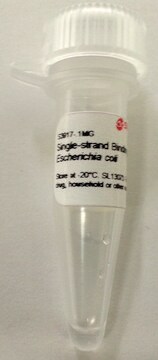F3174
Fpg Protein from Escherichia coli
≥90% (SDS-PAGE), buffered aqueous glycerol solution, >20,000 units/mg protein, suitable for genomic analysis
Sinónimos:
DNA-(apurinic or apyrimidinic site)lyase MutM (APlyase MutM), Fapy-DNAglycosylase, Formamidopyrimidine-DNA glycosylase, Fpg Protein from Escherichia coli, Recombinant, Fapy DNA glycosylase, Formamidopyrimidine DNA glycosylase, MutM
About This Item
Productos recomendados
origen biológico
Escherichia coli
Nivel de calidad
recombinante
expressed in E. coli
Ensayo
≥90% (SDS-PAGE)
Formulario
buffered aqueous glycerol solution
actividad específica
>20,000 units/mg protein
mol peso
30.2 kDa (269 amino acids, predicted from the nucleotide sequence)
composición
protein, 0.1- 0.3 mg/mL Bradford
condiciones de almacenamiento
(Tightly closed)
técnicas
nucleic acid detection: suitable
Nº de acceso UniProt
aplicaciones
genomic analysis
Condiciones de envío
wet ice
temp. de almacenamiento
−20°C
Información sobre el gen
Escherichia coli CFT073 ... mutM(1038243)
Escherichia coli K12 ... mutM(946765)
Descripción general
Research area: Cell signaling
Aplicación
Acciones bioquímicas o fisiológicas
Definición de unidad
Forma física
Código de clase de almacenamiento
10 - Combustible liquids
Clase de riesgo para el agua (WGK)
WGK 2
Punto de inflamabilidad (°F)
Not applicable
Punto de inflamabilidad (°C)
Not applicable
Equipo de protección personal
Eyeshields, Gloves, multi-purpose combination respirator cartridge (US)
Elija entre una de las versiones más recientes:
¿Ya tiene este producto?
Encuentre la documentación para los productos que ha comprado recientemente en la Biblioteca de documentos.
Nuestro equipo de científicos tiene experiencia en todas las áreas de investigación: Ciencias de la vida, Ciencia de los materiales, Síntesis química, Cromatografía, Analítica y muchas otras.
Póngase en contacto con el Servicio técnico



